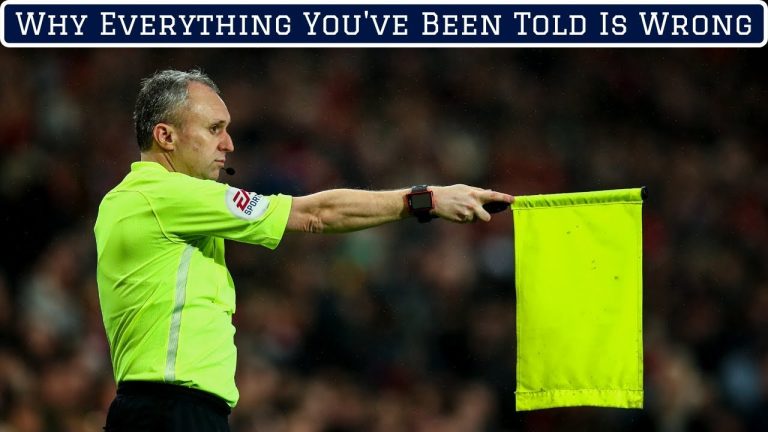The offside rule in football has long been a source of confusion and debate among fans and players alike. Despite its importance in determining fair play, there are numerous misconceptions surrounding this crucial aspect of the game. In this article, we aim to debunk these misconceptions and shed light on the true meaning and application of the offside rule. Whether you’re a casual spectator or a die-hard football enthusiast, this guide will provide you with a clear understanding of this often misunderstood rule.
- Offside is not determined by the player’s position on the field but rather by their position in relation to the second-to-last defender and the ball at the moment the pass is played. This means that a player can be in an offside position but not necessarily offside if they are not involved in active play or are level with the second-to-last defender when the pass is made.
- The offside rule applies only to the attacking team. If a player is in an offside position but the ball is played to them by a teammate from their own half or if they are level with the second-to-last defender when the pass is made, they cannot be called offside. The offside rule is designed to create a fair playing field and prevent attackers from gaining an unfair advantage.
- The offside rule does not apply during throw-ins, goal kicks, or corner kicks. These are considered restarts of play and do not count as a pass for determining offside. Once the ball is in play again, the offside rule comes back into effect.
- The offside rule can be subjective and is open to interpretation by the referee. The decision to call offside can be influenced by factors such as the speed of play, the position of the defenders and attackers, and the referee’s judgment. It is important for players and fans to understand that offside decisions may not always be clear-cut and can vary from game to game.
What are the instances in which offsides is not called?
In the game of soccer, offsides is a common rule that helps maintain fair play. However, there are three exceptions when offsides is not called. Firstly, during a goal kick, throw-in, or corner kick, players cannot be called offside. This allows for more flexibility and strategic positioning during these set-piece situations. Additionally, if a player receives the ball from an opponent who deliberately plays the ball, they are also exempt from being called offside. This exception acknowledges the intentionality of the opposing player and prevents unfair penalties.
When it comes to the rule of offsides in soccer, there are a few exceptions to keep in mind. One exception is during a goal kick, throw-in, or corner kick, where players are not subject to being called offside. This rule allows for more fluidity and freedom of movement during these specific moments in the game. Another exception occurs when a player receives the ball from an opponent who deliberately plays it. In such cases, the offside rule is waived, recognizing the intent behind the opponent’s action and avoiding unjust penalties. By understanding these exceptions, players and fans can better navigate the intricacies of the offsides rule in soccer.
What is the reason for the strictness of the offside rule?
The offside rule is enforced with strictness in order to maintain fairness and prevent players from gaining an unfair advantage. By penalizing players who are in an offside position, the rule ensures that both teams have an equal opportunity to attack and defend. The strictness of the rule also encourages players to actively participate in the game, promoting a more dynamic and exciting gameplay.
By discouraging goal-hanging, the offside rule helps to keep the game engaging and prevents it from becoming monotonous. Without this strict rule, players could simply position themselves near the opponent’s goal, waiting for an easy pass and scoring opportunity. This would undermine the skill and strategy involved in the game, leading to a dull and predictable match. Therefore, the strict enforcement of the offside rule plays a crucial role in maintaining the integrity and excitement of the game of football.
What is the reason behind the change in the offside rule?
In recent years, the offside rule in football has undergone a significant transformation. The introduction of Video Assistant Referee (VAR) technology has played a crucial role in this change. With VAR, referees now have access to instant replays and multiple camera angles to determine whether a player is offside or not. This has led to more accurate decision-making, but it has also caused controversy and heated debates among both experts and supporters. The offside rule’s evolution has become a hot topic in the football world, as it continues to shape the outcome of matches and influence the way the game is played.
The modifications to the offside rule have been met with mixed reactions from players, coaches, and fans. While the implementation of VAR has undoubtedly enhanced fairness and reduced human error, it has also resulted in some highly contentious decisions. The introduction of technology has brought newfound scrutiny to marginal offside calls, leading to goals being disallowed for seemingly minor infractions. This has sparked intense debates about the spirit of the game and whether the offside rule should be revised further. As football continues to embrace technological advancements, the offside rule will likely remain a subject of ongoing discussion, as the sport strives to strike a balance between precision and maintaining the flow and excitement of the game.
Unraveling the Offside Enigma: Separating Fact from Fiction
Unraveling the Offside Enigma: Separating Fact from Fiction
Offside, the enigmatic rule that has baffled football fans for years. Is it a simple concept or a complicated puzzle? Let’s unravel the truth and separate fact from fiction.
First and foremost, let’s debunk the myth that offside calls are subjective and open to interpretation. In reality, offside is a precise and objective rule, with clear guidelines to determine if a player is offside or not. The offside position is determined at the moment the ball is played, and a player is considered offside if they are nearer to the opponents’ goal line than both the ball and the second-to-last defender. It’s a black and white decision, leaving no room for subjectivity.
However, there is a common misconception that offside calls always favor the attacking team. This is far from the truth. In fact, the offside rule is designed to ensure fairness and prevent goal-hanging tactics. It acts as a balancing act between attackers and defenders, ensuring a level playing field. So, next time you witness an offside call, remember that it’s not about favoritism but about maintaining the integrity and fairness of the game.
In conclusion, the offside enigma can be unraveled by understanding the precise nature of the rule and debunking common misconceptions. Offside is not a subjective decision but a clear-cut determination based on objective guidelines. It exists to maintain fairness and prevent unfair advantage for either team. So, the next time offside confuses you, remember to separate fact from fiction and embrace the beauty of this fundamental rule in the game of football.
Offside Rule: Busting Myths and Setting the Record Straight
Offside Rule: Busting Myths and Setting the Record Straight
Paragraph 1: Unraveling the Mystery of the Offside Rule
The offside rule in soccer has long been a subject of confusion and debate among fans and players alike. However, it’s time to set the record straight and bust some common myths surrounding this crucial aspect of the game. Contrary to popular belief, a player is only considered offside if they are nearer to the goal line than both the ball and the second-to-last defender at the moment the ball is played to them. Understanding this fundamental principle will not only clarify the offside rule but also enhance your appreciation for the strategic intricacies of the game.
Paragraph 2: Debunking Misconceptions about Offside
One of the most prevalent misconceptions about the offside rule is that any part of the body, apart from the arms, can be used to play the ball. However, this is far from true. According to the official rulebook, any part of the player’s body that can score a goal, including the head, torso, or legs, is taken into account when determining offside. By debunking this myth, we can ensure a fair and accurate interpretation of the offside rule, leading to a more enjoyable and competitive game.
Paragraph 3: The Offside Trap: A Tactical Masterstroke
While some see the offside rule as a mere technicality, it is, in fact, a tactical weapon that teams can exploit to gain an advantage over their opponents. Coaches often employ a strategy known as the offside trap, where defenders move in unison to catch attacking players offside. By timing their movements perfectly, defenders can force the opposition into making mistakes or restrict their attacking options. Understanding the offside trap and its nuances not only adds excitement to the game but also showcases the strategic brilliance of coaches and players.
Cracking the Offside Code: Clarifying Misunderstandings Once and for All
Paragraph 1:
Offside has long been a source of confusion and controversy in the world of football. However, it is time to unravel the mysteries and clarify the misunderstandings surrounding this rule once and for all. By understanding the offside code, players, coaches, and fans can gain a deeper appreciation of the game and enjoy it to its fullest potential.
Paragraph 2:
The offside rule is actually quite simple. A player is considered offside if they are nearer to the opponent’s goal line than both the ball and the second-to-last defender when the ball is played to them. This means that a player cannot gain an unfair advantage by positioning themselves closer to the goal line than the defenders. The purpose of this rule is to ensure a fair and level playing field for both teams.
Paragraph 3:
To fully comprehend the offside code, it is essential to understand the concept of active involvement. A player is only considered offside if they are actively involved in the play when the ball is played to them. This means that simply being in an offside position does not automatically result in a violation. The player must also be interfering with an opponent or gaining an advantage from their offside position. By clarifying these misunderstandings, we can enhance our understanding of the game and foster a greater sense of fairness and sportsmanship.
In order to fully understand the offside rule, it is crucial to debunk some common misconceptions. By debunking these myths, players, coaches, and fans alike can gain a clearer understanding of the game and appreciate the strategic elements involved. So the next time you watch a match, keep in mind that the offside rule is not as complicated as it may seem, and its correct interpretation can greatly enhance the overall experience of the beautiful game.



